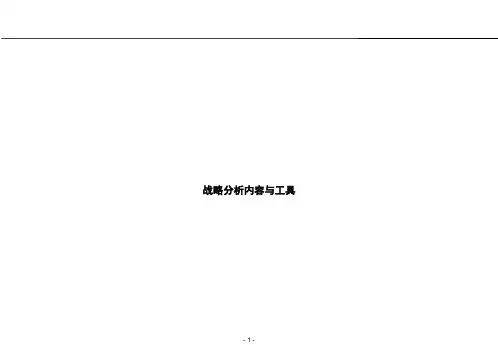罗兰 贝格战略分析工具
- 格式:ppt
- 大小:743.00 KB
- 文档页数:69
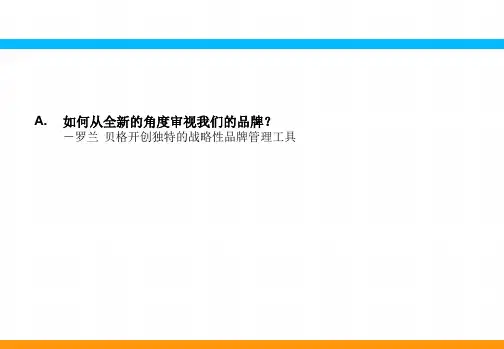


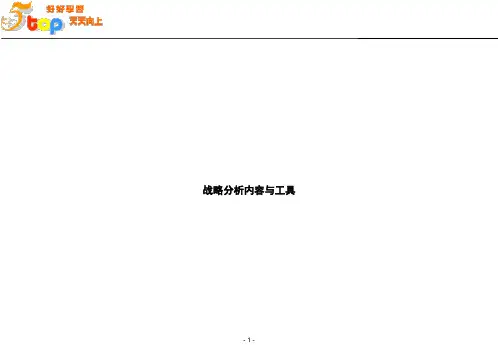
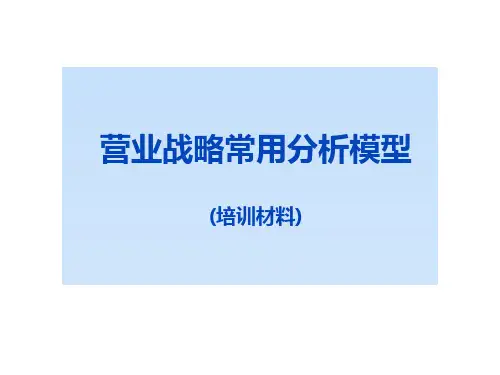
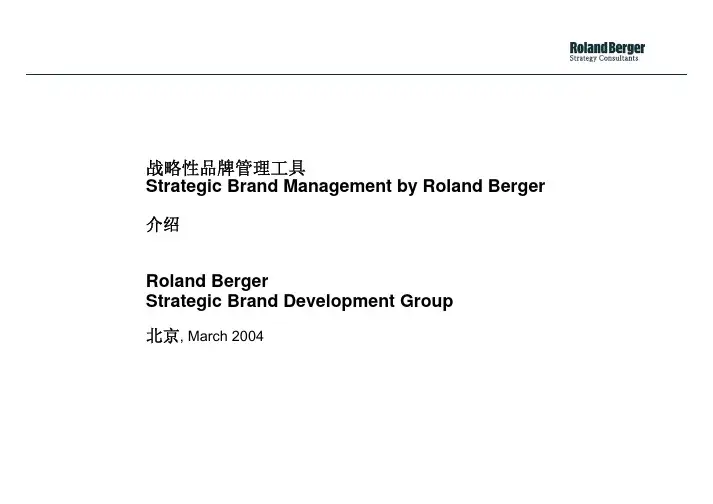
VSVPE +R –Q !更少消费表示集中和有限的需求更少消费更多消费表示需求最大化更多消费产品和服务必须有感受的诉求,如乐趣和道德感性需求理想需求产品和服务必须满足衡量标准,如质量、价格PeopleValues寻求永恒和谐的事物,淡泊的消费欲望寻求生活乐趣,更多的生活体验节省花费,经济上的节省导向寻求绩效和效率,理性的物质选择–+ER'R n e v er 'n e v e b e u r a b l e 'b e r a b l e ' m o r e o d q u a l i t y 'm o r e d q u a l i t y ''A p r i f i t f u l f i l 'A p i f i t f u l 'W h e n b u t o t h e d i 'W h e n b t o t h e d 'I t i s r e p a i ri n g'I t i r e p a i r i n g 16个国家中70000个消费群德国–英国–巴西–墨西哥–中国–日本定性和定量分析因子分析典型消费陈述85 标准陈述多纬分析•团对精神•彼此关爱在电信行业的体现行业领先、业务全面实力雄厚、历史悠久有口皆碑、有信誉的在电信行业的体现技术突破与整合应用创新在电信行业的体现•定制化服务(我的互联星空•一对一、大客户专区在电信行业的体现•网络游戏(动作类)在电信行业的体现•生活品质的提升宽带、无线产品所带来的现代在电信行业的体现•无线空间•移动办公在电信行业的体现•网上社区•移动QQ在电信行业的体现最便宜的话机,二手机The basic orientations简约型价值区传统感性价值区现代感性价值区高尚Fair Fair激情Passion Passion Nature Nature刺激/乐趣Thrill&Fun Thrill&Fun自然• 团对精神 • 彼此关爱 • 志趣相投古典Classic Classic进取AspirationTranquil Tranquil安逸自由自在Carefree Carefree简约Purism Purism归属感Clanning Clanning活力Vitality Vitality新潮/酷New&Cool New&Cool• 活力 • 动感多变 • 积极乐观 • 身心健康 • 亲切热情 • 中肯周到 • 诚挚的 • 想客户所想 • 精准严谨 • 井井有条 • 质量稳定 • 一丝不苟CN服务• 精明 • 货比三家 • 热衷于讨 价还价Service Service创新/科技24/7 Protech 24/7 Protech明智购物Smart Shopping Smart Shopping质量Quality QualityPersonal Efficiency Personal Efficiency个人效率可靠 全面成本Total Cost Total Cost Proven Proven定制化Customized Customized价格敏感区Source: Roland Berger - Strategic Brand Development Group传统理性价值区现代理性价值区21Paul是一个现代理性价值取向较为明显的人,他追求新事物、希望获得尊重 和认可,消费意识较强,但并不太追求时尚和享乐E-E激情 自然 古典 自由自在 归属感 活力 服务E+刺激/乐趣 蓝色代表消费者在这些元 蓝色代表消费者在这些元 素上需求较高 素上需求较高Legend保罗 Paul(高尚)ICP – Individual Consumer Profile (ID 0335)Level 1Level 2 不同意 安逸进取红色表示消费者在这些元 红色表示消费者在这些元 素上需求较低 素上需求较低简约新潮/酷创新/科技Level 1 同意Fair ERE0 R0 E+ R+Consumer value 简约型价值区 价格敏感区 传统感性价值区 传统理性价值区 现代感性价值区 现代理性价值区 Midfield area, high degree of consensus Pro-Value Anti-Value, Demarcation• 25 岁 • 男性 • 单身 • 中等收入 • 中等教育 • 在职 • 4口之家明智购物质量 个人效率 可靠全面成本定制化R-RR+CN!Warning, too weak, should be more intense Warning, too much, should be less intense Conflict with other valueSource: Roland Berger - Strategic Brand Development Group, TNS Data (Germany, March 2002, n=1.500, Population 14-65 yrs., CATI)22如何利用工具来帮助我们进行市场细分 Advanced consumer segmentation24从消费者的价值取向出发我们采用多维聚类的方法将中国消费者划分为 8类消费群都市青年 都市青年Self-centered Self-centered奢华的成功人士 奢华的成功人士ETraditional Maximalists Traditional Maximalists E工薪阶层 工薪阶层节俭主义者 节俭主义者EConformists ConformistsMinimalists MinimalistsE–+–+–+–+29%R14%R13%R12%R及时行乐型 及时行乐型Emotionalists EmotionalistsE专业人士 专业人士Modern Performers Modern Performers E小资型 小资型Progressive Maximalists Progressive Maximalists E知识分子 知识分子Traditionalists TraditionalistsE–+–+–+–+9%R8%R7%R6%R 25Source: Roland Berger - Strategic Brand Development Group (China, Dec.2003, n=3.500, Population Tier 1-2 Citys 14-70 yrs., CATI)Chinese Archetypes - preliminarySEL Chinese Archetype 2003 Study Tier 1-2 Cities TMA CONF MIN MPE PMA TRA EMO1)Share in Population of Tier 1-2 Cities-1--2--3--4--6--7--8--5-29%Self-centered14%13%12%8%7%6%9%Share in Population of Tier 1-5 Cities-6--5--4--7--3--8--1--2-9%10%11%8%13%8%21%Traditionalists14%Chinese Archetype 2001 Study Tier 1-5 Cities SEL TMA CONF MIN MPE PMA TRA DIS2)26Source: Roland Berger - Strategic Brand Development Group, Gallup/ Data (China, Nov2001/Dec2003, n=5.600/3.800, Population yrs., CATI)对于特定市场,我们可以分析该市场的不同类型消费群的结构比例就具体人群的消费群结构Tsd. Persons1.889467女性 14-19E100%276–..+1,889Mio. Persons176Share in sample13824.7%R76 14.6% 9.3% 7.3% 4.0%453634 1.8%28 1.5%Advent2.4%1.9%6.5%OtherWomen 14-19自我型 SELRationalNon- Maximal Emotional Minimal Traditional Altruist conformSource: Roland Berger - Strategic Brand Development Group, Ipsos Data (UK, Aug.2001, n=1.500, Population 12-65 yrs., CATI)27并针对不同细分市场的市场规模和消费能力来判别适合的目标市场Decreasing Economic Relevance市场细分名称 规模 消费能力 对于家电的消 费倾向 排序Rationalists RATMaximalists Self-centered Non-conform MAX SEL NONEmotional EMOAltruists ALTTraditionalists Minimalists TRA MIN1.18,5% 18,5%3.13,9% 13,9%5.9,3% 9,3%8.7,9% 7,9%4.12,5% 12,5%2.16,5% 16,5%7.8,4% 8,4%6.8,8% 8,8%2. 2.1. 3.6. 1.4. 4.3. 5.7. 7.5. 8.8. 6.1.2.3.4.5.6.7.8.1.) in Consumer ElectronicsSource: Roland Berger - Strategic Brand Development Group, TNS Data (Germany, March 2002, n=1.500, Population 14-65 yrs., CATI)28The 'Perception' of brands from the consumer's perspective29The difference between the aggregated value systems of brand users and non-users reveals the perceived value system of a brandE-EPassion Vitality Classic ClanningE+Thrill&Fun Consumer values that the users of Consumer values that the users of the brand most often agree with – the brand most often agree with – i.e. the most recognized value i.e. the most recognized value proposition of the brand proposition of the brandLegendProgressive hedonism patternNikeAVP - Actual Value Perception (415 vs. 1.085; zmax=12.7) maxUser Non-UserFair NatureCarefree New&CoolEPurismTranquilValue pole Value pole E = Emotional R = Rational + = More - = Less Value clusterService Smart ShoppingIntensity Precision Level 1Level 3Level 224/7 ProtechFair Consumer value, value proposition Midfield area, high degree of consensus Pro-Value Anti-Value, demarcation Warning, too much, should be less intense Warning, too weak, should be more intensePersonal Efficiency ProvenTotal Cost CustomizedR-RR+!Conflict with other valueSource: Roland Berger - Strategic Brand Development Group, Emnid Data (Germany, March 2002, n=1.500, Population 14-65 yrs., CATI)30E+E-R+ R-E R SmartShopping Total Cost Nature Fair Purism Tranquil Thrill&Fun New&Cool Carefree Vitality Clanning Passion Classic Customized PersonalEfficiency 24/7Protech Service Precision Proven Anti-minimalism pattern Anti-traditional pattern Consumer values that the users of disagree with i.e. 'aversions' that the brand might Consumer values that the users of disagree withi.e. 'aversions' that the brand might Consumer values that the users ofthe brand most often Consumer values that the users of the brand most often Progressivehedonism patternE +–R E +–R E+–RE +–R E +–R E+–RE +–R E +–RE+–RE+–RE+–RE+–R52467Carline 'S'Carline 'C'Carline 'E' 'Minimalist''Traditionalist''Luxury/ Status''Hedonist'E+–RE +–R E +–R E +–R E +–RE+ E-R+ R-E R Purism Purism Smart Shopping Smart Shopping Total Cost Total Cost Nature Nature Fair Fair Tranquil Tranquil Thrill&Fun Thrill&Fun New&Cool New&Cool Carefree Carefree Vitality Vitality Clanning Clanning Passion Passion Classic Classic Customized Customized Personal Efficiency Personal Efficiency 24/7Protech 24/7Protech Service Service Quality Quality Proven Proven E+ E-R+ R-E R Purism Purism Smart Shopping Smart Shopping Total Cost Total Cost Nature Nature Fair Fair Tranquil Tranquil Thrill&FunThrill&FunNew&Cool New&Cool Carefree Carefree Vitality Vitality ClanningClanning PassionPassion Classic Classic Customized Customized Personal Efficiency Personal Efficiency 24/7Protech 24/7Protech Service Service Quality Quality Proven Proven E+E-R+ R-E R Purism Purism SmartShopping Smart Shopping Total Cost Total Cost Nature Nature Fair Fair Tranquil Tranquil Thrill&FunThrill&Fun New&CoolNew&Cool Carefree Carefree VitalityVitality Clanning Clanning Passion PassionClassic Classic Customized Customized PersonalEfficiency Personal Efficiency 24/7Protech 24/7Protech ServiceService Quality Quality ProvenProvenNature SmartShopping Proven Customized Thrill&FunTotal Cost Fair Purism New&Cool Carefree Vitality Tranquil Quality Service Clanning Passion Classic Personal Efficiency 24/7Protech E +–RNature SmartShopping Proven Customized Thrill&Fun Total Cost Fair Purism New&Cool Carefree Vitality Tranquil Quality Service Clanning Passion Classic Personal Efficiency 24/7Protech E +–R借助Profiler 品牌战略分析工具可以明显地揭示各品牌的强势与弱势所在, 以及品牌所面对的竞争环境品牌 'A' – PVP ProjectionE品牌 'B' – PVP ProjectionE 2000<Carefree> <Carefree> <Clanning> <Clanning> <Protech> <Protech>Brand 'C' 品牌 'C' – PVP ProjectionE<New&Cool> <New&Cool> <Classic> <Classic>PVP 广告分析<Classic> <Classic> <Tranquil> <Tranquil>品牌投射–+<Protech> <Protech>–+<Quality> <Quality> <SmartShop> <SmartShop>–+<Protech> <Protech>1996-98 R<SmartShop> <SmartShop>R<Proven> <Proven>R品牌 'A' – AVP PerceptionEPassion Fair Thrill&Fun Vitality Classic Carefree New&Cool品牌 'B' – AVP PerceptionEPassion Fair Nature Purism Vitality Thrill&Fun品牌 'C' – AVP PerceptionEPassion Fair Nature Purism Classic Vitality Carefree New&Cool Thrill&Fun实际认知效果分析品牌认知Nature PurismClassic social hierarchy Carefree Clanning New&CoolLower 'ranks' in消费倡导者 的性格特征TranquilClanningTranquilTranquilClanning–Service Smart Shopping Quality 24/7 Protech+Personal Efficiency Proven Total Cost–Service Smart Shopping Quality 24/7 Protech+Personal Efficiency Proven–Service Smart Shopping Quality 24/7 Protech+Personal Efficiency Proven创新者的 性格特征RCustomizedTotal CostRCustomizedTotal Cost 最低要求者 的特征'RCustomizedSource: Roland Berger - Strategic Brand Development Group, Data from Metris (Portugal, Oct.2000, n=1.500, Population 15-65 yrs., CATI)41“节俭主义者”是品牌B 吸引的主导消费者类型,用户群结构对未来发展不利消费者基础与消费者类型分析主导的消费者类型品牌 B – AVP (年轻人)EPassion Fair Nature Purism Classic Vitality Carefree New&Cool Thrill&FunTranquilClanning–Service Smart Shopping Quality 24/7 Protech+Personal Efficiency Proven Total Cost100% 80% 60% 40% 20% 0% -20% -40% -60% -80% -100% Dev74,3% 46,0% 40,7% 37,3% 61,1%超过平均值 超过平均值社会阶级层次 较低!!!-31,7%-58,3%低于平均值 低于平均值- 60,8% 创新者 -60,8%-52,6% 胜利者 -52,6% 传统主义者 无关主义者 人道主义者 利他主义者 节俭主义者 自我抑制型 46,0% 40,7% 61,1% 37,3% 74,3% -31,7%RCustomized消费倡导者 -53,3%经济相关性不断下降!与主导的消费者类型冲突 与主导的消费者类型冲突42Source: Roland Berger - Strategic Brand Development Group, Data from Metris (Portugal, Oct.2000, n=1.500, Population 15-65 yrs., CATI)品牌C 吸引的消费者类型中,消费人群较为复杂消费者基础与消费者类型分析主导的消费者类型品牌 C – AVP (年轻人)EPassion Fair Nature Purism Classic Vitality Carefree New&Cool Thrill&FunTranquilClanning–Service Smart Shopping Quality 24/7 Protech+Personal Efficiency Proven Total Cost100% 80% 60% 40% 20% 0% -20% -40% -60% -80% -100% Dev68,4% 42,8%78,6%超过平均值 超过平均值48,7% 14,3%!8,3% -33,8%低于平均值 低于平均值!-64,7% 创新者 42,8% 胜利者 24,6%-58,0%RCustomized消费倡导者 68,4%传统主义者 无关主义者 人道主义者 利他主义者 节俭主义者 自我抑制型 -64,7% -58,0% -33,8% 48,7% 8,3% 14,3%经济相关性不断下降1.) 节俭主义者和消费倡导者/胜利者无法很好地匹配 C品牌的消费群中的节俭主义者的份额增长将有可能导致消费倡导者消费类型放弃此品牌!与主导的消费者类型冲突 与主导的消费者类型冲突43Source: Roland Berger - Strategic Brand Development Group, Data from Metris (Portugal, Oct.2000, n=1.500, Population 15-65 yrs., CATI)战略品牌分析解释了市场背景情况,及品牌B 在年轻消费者市场逐渐丧失 份额的背后原因品牌 'A' 品牌投射目前的品牌组成 (PVP)品牌 'B'品牌 'C'协调性品牌投射的长期效果 (PVP over time)品牌认知市场地位概况,驱动力 (AVP)消费者基础消费群类型的组成 (CBA)排名 目前增长趋势2.3.1.优好,适中差44Source: Roland Berger - Strategic Brand Development Group品牌B 无法在年轻消费者市场取得成功 – 必须引入一个全新的品牌D,以避 免过渡地对品牌B 进行无效品牌延伸市场特征语言, 图像,文字,音效 • 可预见 • 严肃认真 • 传统 • 精准 • 可信赖 • 前/ 后 • 追求完美 • 大方端庄 • 注重产品内部细节 • 新奇有趣 • 随时自发 • 主动积极 • 缤纷多变 • 注重产品外观 • 令人惊喜 • 与众不同 • 生动活泼 • 休闲市场划分 VIP’s品牌架构 • 更注重理性价值品牌执行要求的技能'B'强势大多数为30岁以上 的成功人士, 阅历 丰富,成熟稳重• 可靠 • 不注重感性价值 • 值得信赖 • 更注重感性价值 • 协调一致 • 不注重理性价值年轻人'B'弱势大多数为25岁以下的 青年人,反叛, 自我,蔑视权威品牌 ‘B’ 无法同时满足两种对立的目标消费群的不同要求因此必须引入全新的品牌D – 并且确保品牌B坚守其原有的品牌定位Source: Roland Berger - Strategic Brand Development Group45对于品牌D 的市场进入策略,有三种可选方案备选方案价格导向E Brand C主流价值导向E Brand C Brand A Brand A时尚型E Brand C目标品牌定位Brand A–+–+–+RRR主导品牌 定位元素<全面成本t> <明智购物> <科技/创新><归属感> <科技> <可靠/经典> <明智购物> <质量> <服务> <简约><科技/创新> <新潮/酷> <归属感> <激情> 反对-<经典> 反对-<可靠> 反对-<简约>辅助品牌 定位元素<归属感> <质量> <服务> <简约>Source: Roland Berger - Strategic Brand Development Group46采取“时尚型”的市场进入方案将为品牌D 带来更大的竞争优势,同时给品 牌C 和品牌A 带来威胁品牌 ‘D’ – 时尚型定位E <新潮/酷> 要素<Classic> <Classic>品牌 'C'E 品牌C无法很好地集中 在<新潮/酷>上…品牌 'A'E<Classic> <Classic>!–… 将会迫使品牌C直接对 品牌A进行竞争– 规避传统主义者 规避节俭主义者 R+关键驱动 要素+–+… 从而迫使品牌C往回退到<经典>, 并有可能最终退到<明智购物>上 R R• “时尚型”品牌定位凸显 <新潮/酷 >元素,相比较与<经典>结合, 这更易令人 信服 • 凸显<新潮/酷> 并弱化<经典> 能很好地吸引创新者消费群, 并影响消费倡导者• 品牌C很难成功地集中在 <新潮/ 酷>上,从而降低了其可信度, 无法很好地吸引“胜利者” • 品牌 ‘C’ 将被迫只集中在<经典 >上,并且最终在 <明智购物> 上• 品牌C 若集中在<经典>上,将 无可避免地产生与品牌A的直接 竞争 • 这将对品牌B产生好处Source: Roland Berger - Strategic Brand Development Group47通过以上策略性分析过程,导出了品牌D 的目标品牌价值定位,这将作为 其整个品牌营销组合的指导原则品牌 B – AVP (年轻人)EPassion Fair Nature Purism Classic Vitality Carefree New&Cool Thrill&FunFair Nature Purism Classic品牌 D – TVP (年轻人)EPassion Vitality Carefree New&Cool Thrill&FunTranquilClanningTranquilClanningPro-Innovator Attractor–Service Smart Shopping Quality 24/7 Protech+Personal Efficiency Proven Total Cost–Smart ShoppingService Quality+24/7 ProtechAnti-Minimalist SeparatorPersonal Efficiency ProvenMobile phone EnablerTotal CostR 分析100% 80% 60% 40% 20% 0% -20% -40% -60% -80% -100% DevCustomizedPro-Innovator Customized R Attractor策略性分析过程74,3% 46,0% 61,1%above average above average目标increase increase++ +-31,7%40,7%37,3%!!!-58,3% Maximalist -53,3%below average below average- 60,8%-52,6%-Sharedecrease decreaseInnovator Succeeder Traditional Indifferent Humanist -60,8% -52,6% 40,7% 37,3% 46,0%Altruist 61,1%G.Minimal Minimalist 74,3% -31,7%Maximalist14,7%Innovator Succeeder Traditional Indifferent Humanist11,7% 8,7% 19,7% 5,7% 7,7%Altruist8,7%G.Minimal Minimalist12,5% 8,7%Distance from Market Protagonists Decreasing Economic RelevanceDecreasing Economic Relevance Distance from Market ProtagonistsSource: Roland Berger - Strategic Brand Development Group48品牌D 的营销组合必须同时满足支持其品牌拥护者并打击其品牌竞争对手的 目的品牌 'D'Target Value Proposition Target Value PropositionEPassion Fair Nature Purism Classic Vitality Carefree New&Cool Thrill&FunTranquilClanning–Smart ShoppingService Quality+24/7 ProtechPersonal Efficiency Proven‘创新者'Target ProtagonistTotal Cost Customized‘节俭主义者'Target AntagonistsROKNOScale for approval产品• 开发显示 <科技> 特征的产品 ,如手机“个人游戏” 或“个人网 络” 等价格• 制定中高档定价策略 • 5-10% 略高于竞争对手渠道• 提出反对<科技>感觉的包装和 宣传品的创意 • 对代理商进行培训,吸引更多 的“创新者”并将“节俭主义者”驱 赶给品牌C推广• 基于TVP设计品牌标识,并进 行相关的品牌宣传推广Source: Roland Berger - Strategic Brand Development Group49。
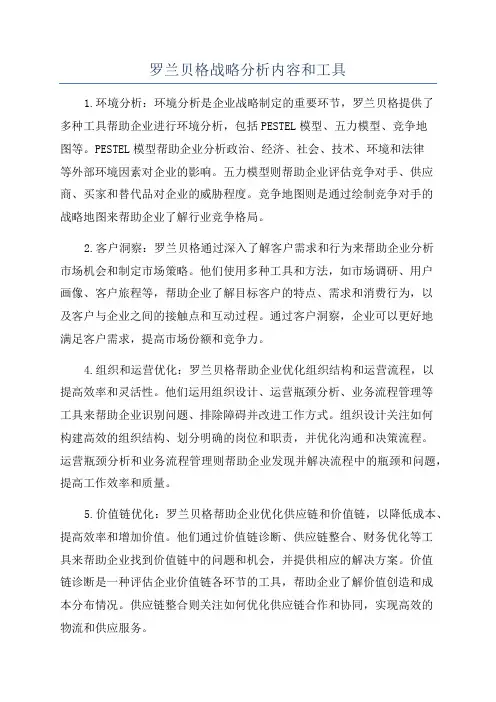
罗兰贝格战略分析内容和工具1.环境分析:环境分析是企业战略制定的重要环节,罗兰贝格提供了多种工具帮助企业进行环境分析,包括PESTEL模型、五力模型、竞争地图等。
PESTEL模型帮助企业分析政治、经济、社会、技术、环境和法律等外部环境因素对企业的影响。
五力模型则帮助企业评估竞争对手、供应商、买家和替代品对企业的威胁程度。
竞争地图则是通过绘制竞争对手的战略地图来帮助企业了解行业竞争格局。
2.客户洞察:罗兰贝格通过深入了解客户需求和行为来帮助企业分析市场机会和制定市场策略。
他们使用多种工具和方法,如市场调研、用户画像、客户旅程等,帮助企业了解目标客户的特点、需求和消费行为,以及客户与企业之间的接触点和互动过程。
通过客户洞察,企业可以更好地满足客户需求,提高市场份额和竞争力。
4.组织和运营优化:罗兰贝格帮助企业优化组织结构和运营流程,以提高效率和灵活性。
他们运用组织设计、运营瓶颈分析、业务流程管理等工具来帮助企业识别问题、排除障碍并改进工作方式。
组织设计关注如何构建高效的组织结构、划分明确的岗位和职责,并优化沟通和决策流程。
运营瓶颈分析和业务流程管理则帮助企业发现并解决流程中的瓶颈和问题,提高工作效率和质量。
5.价值链优化:罗兰贝格帮助企业优化供应链和价值链,以降低成本、提高效率和增加价值。
他们通过价值链诊断、供应链整合、财务优化等工具来帮助企业找到价值链中的问题和机会,并提供相应的解决方案。
价值链诊断是一种评估企业价值链各环节的工具,帮助企业了解价值创造和成本分布情况。
供应链整合则关注如何优化供应链合作和协同,实现高效的物流和供应服务。
以上是对罗兰贝格战略分析内容和工具的简要介绍。
通过环境分析、客户洞察、业务模式创新、组织和运营优化以及价值链优化,企业可以更好地理解市场和客户需求,制定有效的战略并实现可持续发展。
